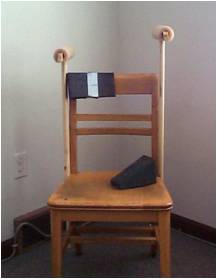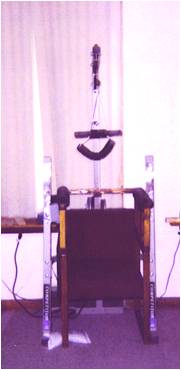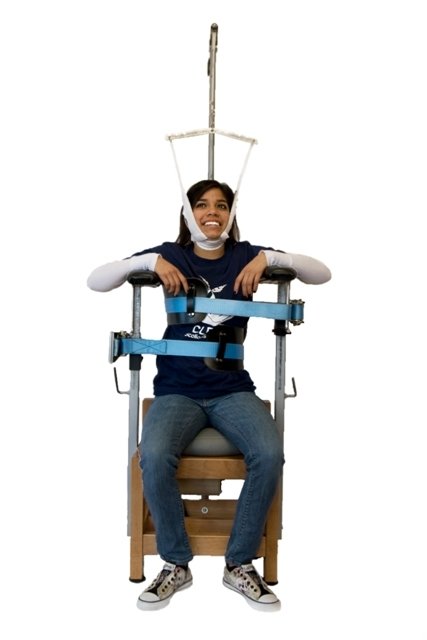History of the
Scoliosis Traction Chair

The Scoliosis Traction Chair (STC) was developed by the CLEAR Institute to be the ultimate tool to address and rehabilitate the scoliotic spine. The very first scoliosis chairs were modified school chairs customized by hand for each patient. The armrests were built up with foam blocks affixed with duct tape, according to a patient’s posture. The entire system was then placed on top of a vibrating platform. Initial results were encouraging but its application in a clinical setting was limited due to the customized nature.
A cervical traction component was added to the next model and a motor was attached directly to the chair. However, when the chair was turned on without a person seated in it, it would “float” across the floor and when a patient was seated, more of the vibration transmitted into the floor than the patient.
While attending Palmer Chiropractic School in Davenport, Iowa, Dr. Clayton Stitzel had the good fortune to meet and be mentored by Dr. Dennis Woggon. The work that Dr. Woggon was doing with scoliosis patients was innovative and challenging, and Dr. Stitzel was inspired to join him in this endeavor.
Dr. Woggon had already begun developing a treatment protocol that used vibration and traction to successfully treat patients with scoliosis. Dr. Stitzel suggested his father, Mr. John Stitzel, who had years of experience in engineering, aid them in the development of the scoliosis chair.
At first foam blocks needed to be taped in place for each individual patient, and the un-padded lateral traction straps were tightened in place manually by the doctor. Initially, most of the patients who saw the two doctors were adolescents, but increased demand from adult patients led to the adjustable arms so both adolescents and adults could be accommodated.

Dr. Stitzel soon realized the narrow chest and waist belts were very uncomfortable. Belt support hooks were added under the arm rests, and Mr. John Stitzel recruited the help of an Amish gentleman who agreed to handcraft leather pads that would distribute pressure more evenly, making the straps more comfortable for the patient and allowing the patient to tolerate a longer session in the chair. The new pads also improved the amount of lateral force that could be applied to straighten the spine. To achieve the necessary decompression that would allow the spine to further correct, a cervical traction component was incorporated with a post and pulley system mounted on the chair backrest. In addition, the backrest was designed with the ability to rotate, as well as to raise and to lower. X-rays taken of patients in the chair now proved that their spine was being repositioned completely back to the ideal by the 3-dimensional activity of the Scoliosis Traction Chair.
The manual traction belts were replaced with a ratchet system that allowed doctors more precise control on the amount of traction they applied to the patient. It also made it possible for patients to effectively use the chairs in their homes. In the fall of 2004, Dr. Stitzel began using one of the original chairs and one was sent to Dr. Woggon. At this point, the vibration was achieved by setting the chair on a vibrating platform. The vibration needed to be directed into the chair and isolated from the floor. In the winter of 2005, a Scoliosis Traction Chair with a vibrating motor attached was custom-designed and tested in Dr. Stitzel’s clinic. This design was evaluated next to a chair on a vibrating platform, to compare results between patients using only one version exclusively, and suggestions and comments from other patients who were allowed to use both chairs. While both versions proved to be very effective, the complete chair had become popular with doctors and patients for its efficiency, ease of its use, and practicality. In the spring of 2005, Mr. Stitzel completed the chair design that is essentially the chair that CLEAR is manufacturing today. In the winter of 2007, a patent was approved and the Scoliosis Traction Chair went into full production at Lewis Motor Repair in Waite Park, Minnesota.
How the Scoliosis Chair works

This chair is designed to further open up the scoliotic curves and derotate the spine. The Scoliosis Traction Chair (STC) uses a specific frequency of vibration, to cause the muscles of the spine to contract at a higher frequency than normal, accelerating healing. Whole Body Vibration is implemented as the entire body is exposed to vibration, as opposed to local vibration (Biomechanical Stimulation, BMS), where an isolated muscle or muscle group is stimulated by the use of a vibration device. A key principle of the scoliosis traction chair is that it allows the patient to work their core muscles in a scoliosis free posture, thus re-training the neuromuscular system to improve alignment and muscle recruitment.
Research conducted by physicists (not physicians) and digital motion x-ray of patients in the scoliosis chair, show that the normal biomechanics are being restored, strengthened with muscle training, and posture re-education is taking place while the patient is using the scoliosis chair properly.
Proper use of the Scoliosis Traction Chair:
- Begins with 10-15 mins daily and gradually increases to 20-25 mins twice daily.
- 10-20 lbs of neck traction is applied (increased based on patient’s tolerance level).
- Side traction straps are applied as tightly as possible over the primary curve, and only slightly less on the secondary curve.
- Patient is seated far back in the chair with chin raised slightly to maintain the normal neck position.
- Arm rest may be raised as high as possible to traction the spine; one arm is slightly higher on the low shoulder side.
- Backrest may be rotated approximately 20-30 degrees into the protruding thoracic rib arc.
- Head halter is applied under the chin and the base of the skull.
Scoliosis is often accompanied by evidence of disc degeneration, osteoporosis, congenital malformation, and disc wedging. Whole-Body Vibration therapy helps to address these symptoms in accordance with established laws of biomechanics. Wolff’s Law states that a bone under stress will heal faster and Davis’ Law states that soft tissues such as ligaments and muscles will also heal more efficiently while under stress. These same principles apply to healthy tissues, as well. Tissues adapt and become stronger when greater stress or weight is applied to them. Whole Body Vibration has been demonstrated scientifically to increase bone density, relieve pain and inflammation, and increase flexibility by stimulating the various tissues and systems of the body (bone, muscle, and collagen).
Rotation and translation occur as a combined motion in the spinal column and it is impossible to address one dimension without effecting the other. For this reason, you cannot rehabilitate scoliosis unless you address it three-dimensionally. Research has shown that abnormal rotation of the spine develops either prior to or during the onset of scoliosis, but rotatory misalignment is always present. The Scoliosis Traction Chair is designed to incorporate derotation, decompression, and sideways pressure while simultaneously providing stabilization of the posterior thoracic rib arch. It also isolates the trunk rotator muscles on one side to isometrically (without motion) to strengthen the weakened core musculature.
Where to buy
Scoliosis Traction Chairs
New & Reconditioned Chairs: vibeforhealth.com
*A new leasing program has just been released. Contact our office for more details.*